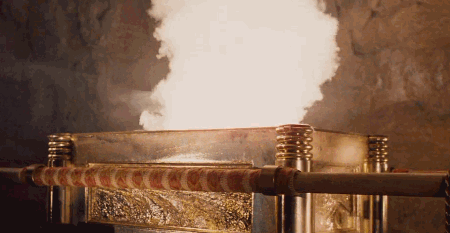If you’re a movie or TV buff, you may have heard the term “MacGuffin” (alternately “McGuffin”) quite a bit in discussions about your favorite titles over the years. It’s a word that has taken on a life of its own with regard to how we talk about storytelling… but what is it, exactly?
The short version is: It’s that thing that drives the plot forward. Sometimes physical, sometimes multi-layered, but always doing more than just driving characters from point A to point B; usually, it’s a reflection of who they are or what drives them. Wikipedia describes it this way: “The most common type of MacGuffin is a person, place, or thing (such as money or an object of value). Other more abstract types include victory, glory, survival, power, love, or some unexplained driving force.” We thought it would be fun, as this month’s theme is ARTIFACTS (celebrating titles that usually feature some kind of MacGuffin in the plot eventually!) to do a Friday Five round-ups of some our favorite examples of this time-tested trope…
Hitchcock Shepherds “MacGuffin” Into Pop Culture
English screenwriter Angus MacPhail is credited with having coined the term “MacGuffin,” but it is Britain’s most celebrated film director who brought the concept into the vernacular of cinephiles and geeks everywhere. Alfred Hitchcock relied on the device in several of his films, and the video clip you see above is cobbled together from some of his interviews where he explained the origin of the term (which may very well be made up, by the way) and the manner in which writers use it. It’s interesting to note Hitch emphasizing that while MacGuffins are important to the characters, “the audience don’t care”; one could argue that in later examples (such as the glowing briefcase in Pulp Fiction) the audience’s curiosity was piqued a great deal, even if ultimately the actual importance to the plot was nil.
Raiders of the Lost Ark: The Classic MacGuffin Introduction
In the early years of our current era of the summer blockbuster, the likes of Steven Spielberg and George Lucas did a lot to re-energize the use of the MacGuffin in popular movies. In their hands, said MacGuffins often transcend the aforementioned “the audience doesn’t care” notion. (The plans inside R2-D2 in Star Wars: A New Hope are technically the MacGuffin, but we were awfully invested in Artoo’s safety as well.) Perhaps the most beautifully realized introduction of a MacGuffin, meanwhile, is this pitch-perfect scene early in Raiders of the Lost Ark in which Indiana Jones (in full hot-professor mode) explains the Ark of the Covenant and its significance to some G-men (and us), as well as foreshadows the moral quandry it poses down the line. (The Germans intend to exploit the Ark’s tremendous power; ultimately, Indy and Marion only survive the final climax by refusing to even look at the thing.)
The Original MacGuffin: The Holy Grail
It probably goes without saying that the sort of device a MacGuffin entails didn’t spring to life when the term was invented; it’s been part of myths and legends for centuries. One of the earliest and best-known examples, of course, is The Holy Grail – so much of Arthurian legend, the Knights Templar, etc. revolves around the quest for the chalice of Jesus Christ, but the actual finding of it is of very little consequence. (Let’s also recognize that as a popular euphamism for a sought-after object, “Holy Grail” is itself right up there with “MacGuffin” in terms of popularity.) Nearly every popular interpretation of the quest for the Grail (including the aforementioned Dr. Jones’s third outing) has really shined in the details of how it shapes its protagonists. And every once in a while, the inconsequence of achieving the goal of finding it is perfectly (even hilariously) demonstrated, as the Monty Python team did in their 1975 adaptation of King Arthur and the Knights of the Round Table’s quest. Which ends like this. Womp womp.
Alias: Rambaldi, aka the Long Game MacGuffin
While he’d enjoyed a sizeable success with Felicity earlier in the 90s, it was Alias that firmly put JJ Abrams on the map as a genre storyteller, and Jennifer Garner as an action-capable leading lady. While the show was basically a family melodrama sandwiched in an espionage thriller, a healthy side order of science fiction joined the fray early on with the introduction of Milo Rambaldi: 15th century inventor and philosopher whose predictions and prophecies (think DaVinci meets Nostradamus) are in the present day a gold mine for governments and shadow groups to pillage the world over. The degree to which Rambaldi’s MacGuffin-influence over Alias’s five-year run was a good thing or a bad thing remains a source of heated debate among fans. (Certainly, Sydney Bristow’s family matters were compelling enough without the prophecy stuff that often drove it.) Yet introducing dazzling, bizarre tech into the show thanks to Rambaldi was also part of its appeal – like, for example, the Season One finale (above) in which Sydney’s destruction of a mysterious water-bending Rambaldi device makes for a rad running sequence (and mega angst where it looks like totally-not-her-boyfriend-yet Vaughn might drown. It was EMOTIONAL, ‘kay?)
Mightiest MacGuffin?: The Legend of the One Ring
As we mentioned, this device has roots in tall tales and legends of yore – the same sort of myths and legends that inspired J.R.R. Tolkien in the mid-20th Century to write the trilogy of novels that would later widely be considered his masterpiece. For absolute all-encompassing driving power behind the plot of the story as well as holding up a mirror of character development to virtually every single key player in the darn thing – and there are many – The One Ring may be the most complex and formidable MacGuffin of all time. It can reduce otherwise honorable men to doubting, uncertain victims of the lure of power. (Alas, Boromir, we hardly knew ye.) It can be a spiritual litmus test whose undeniable allure puts the most noble of leaders, such as the elf queen Galadriel, through the wringer of temptation and out the other side even stronger. Most of all, the physical presence of this glittering icon of evil literally moves the entire saga forward as every human, elf, dwarf, orc, wizard and hobbit converges on the gates of Mordor in The Return of the King. Poor Frodo’s burden is to try and withstand its temptation (and Gollum’s schemes) long enough to destroy it; thankfully he has the purest Hobbit of all to help him with that. (Go watch that link when you have a sec and have that Kleenex handy! In the meantime, watch the ring’s magnificent introduction above!)




